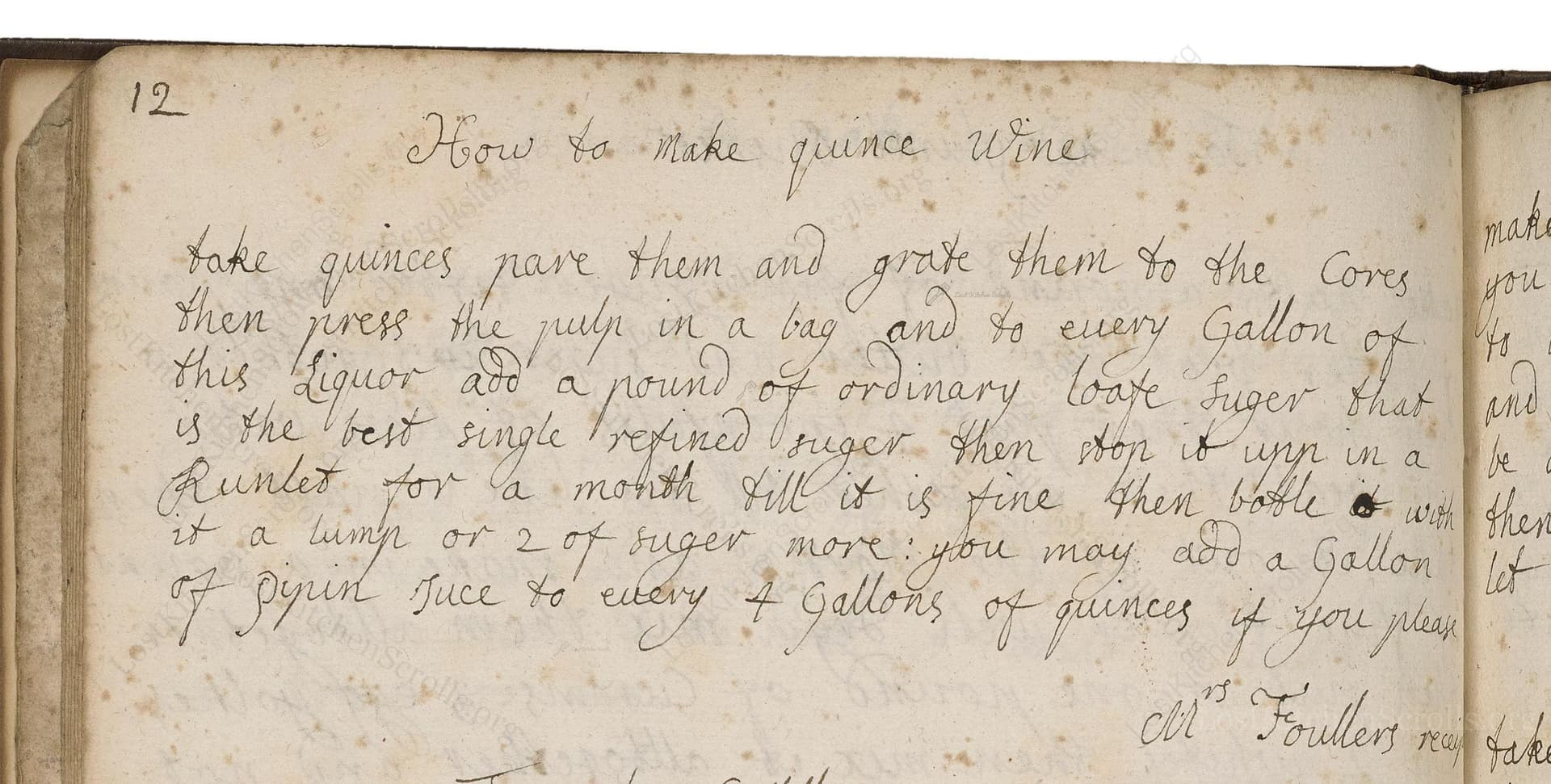How To Make Quince Wine
From the treasured pages of Receipt book
Unknown Author

How To Make Quince Wine
"Take quinces pare them and grate them to the Cores then press the pulp in a bag and to every Gallon of this liquor add a pound of ordinary loafe suger that is the best single refined suger then stop it upp in a Runlet for a month till it is fine then botle it with a lump or 2 of suger more: you may add a Gallon of pipin Juice to every 4 Gallons of quinces if you please. Mrs Foullers receit"
Note on the Original Text
The recipe is written in direct, conversational English from around 1700, marked by period spellings—'suger' for sugar, 'loafe' for loaf, and 'stop it upp' for sealing or stopping the cask. Measurements were typically by volume or weight as understood in the household and could vary, so precision was based on practical knowledge and the scale of the kitchen. The instructions rely on the cook’s judgment and experience, with optional variations ('if you please') included. The punctuation and lack of standard grammar also reflect its manuscript origins.

Title
Receipt book (1700)
You can also click the book image above to peruse the original tome
Writer
Unknown
Era
1700
Publisher
Unknown
Background
A delightful glimpse into the kitchens of the early 18th century, this historic culinary manuscript promises a feast of recipes, remedies, and perhaps a pinch of mystery. Expect both practical fare and elegant inspiration for the curious cook.
Kindly made available by
Folger Shakespeare Library
This recipe is taken from an English household manuscript dating to around 1700, a period when home winemaking was widespread among the gentry and well-off households. Fruits like quince were commonly used for fermenting into wine or cordial, as quince trees were often found in kitchen gardens. Sugar, a luxury but increasingly available by the late 17th century, provided both flavor and the fuel for fermentation. Recipes like this one, attributed to Mrs. Foul(l)er, reflect both practical knowledge and the gentlewoman’s pride in household management. The use of 'pipin juice' (from 'pippins', a type of apple) reflects an era where blending fruits was common and regional apple varieties were prized. Such handwritten recipes in collections helped preserve culinary techniques before printed cookbooks became widespread.

Historical kitchen tools included a sharp knife or paring tool for peeling, hand graters (usually made of metal or tin), large linen or muslin bags for pressing pulp, and wooden presses or weights for extracting juice. The fermentation took place in small wooden casks or runlets, carefully stopped with cloth and wax or wooden bungs. Bottling would involve thick glass bottles (often reused) and hand-sealed corks, with sugar lumps measured for each bottle.
Prep Time
1 hr
Cook Time
0 mins
Servings
6
We've done our best to adapt this historical recipe for modern kitchens, but some details may still need refinement. We warmly welcome feedback from fellow cooks and culinary historians — your insights support the entire community!
Ingredients
- 9 lb quinces
- 1 lb white caster sugar (or finest available sugar)
- Optional: 2.2 lb apples (for 1 quart apple juice, use tart apples like Granny Smith for 'pippin')
- Additional 1/3–2/3 oz sugar per bottle for bottling
Instructions
- To make quince wine in the style of the early 18th century, start by peeling and grating fresh quinces down to their cores.
- Press the grated quince pulp in a muslin bag or fine cheesecloth to extract as much juice as possible.
- For every 4 quarts of quince juice, add about 1 pound of white sugar (you can use ordinary caster sugar as a modern equivalent of 'loafe sugar').
- Stir to dissolve completely.
- Pour this mixture into a fermentation vessel with an airlock and let it ferment undisturbed for about a month until it becomes clear and stops bubbling.
- Once fined, carefully siphon off the wine and bottle it, adding another lump or two of sugar (about 1/3 to 2/3 ounce per bottle) to each bottle before sealing.
- Optionally, you may add 1 quart of fresh apple (pippin) juice for every 4 quarts of quince juice if you wish a milder flavor.
- Store the bottle for a few more weeks to allow a gentle secondary fermentation and enjoy.
Estimated Calories
200 per serving
Cooking Estimates
This recipe takes about 1 hour to prepare the fruit and juice, and there is no actual cooking involved. Each bottle contains about 200 calories from fruit sugars and added sugar. The recipe yields about 6 bottles of wine.
As noted above, we have made our best effort to translate and adapt this historical recipe for modern kitchens, taking into account ingredients nowadays, cooking techniques, measurements, and so on. However, historical recipes often contain assumptions that require interpretation.
We'd love for anyone to help improve these adaptations. Community contributions are highly welcome. If you have suggestions, corrections, or cooking tips based on your experience with this recipe, please share them below.
Join the Discussion
Rate This Recipe
Dietary Preference
Main Ingredients
Culinary Technique
Occasions

Den Bockfisch In Einer Fleisch Suppen Zu Kochen
This recipe hails from a German manuscript cookbook compiled in 1696, a time whe...

Die Grieß Nudlen Zumachen
This recipe comes from a rather mysterious manuscript cookbook, penned anonymous...

Ein Boudain
This recipe comes from an anonymous German-language manuscript cookbook from 169...

Ein Gesaltzen Citroni
This recipe, dating from 1696, comes from an extensive anonymous German cookbook...
Browse our complete collection of time-honored recipes



